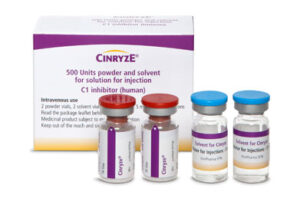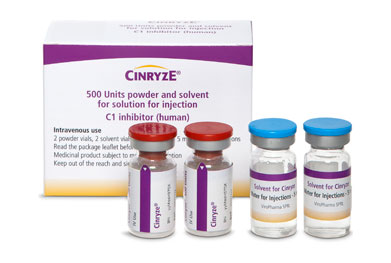Cinryze | cinryze cost | cinryze price |100% Best Sale
$493,706.00
Cinryze is a synthetic form of a blood protein that plays a crucial role in regulating swelling. Individuals with hereditary angioedema lack sufficient levels of this protein, resulting in symptoms such as abdominal problems or respiratory difficulties due to swelling. Cinryze is made to prevent and treat these angioedema attacks.
Description
Introduction to Cinryze | cinryze cost | cinryze price
Definition of Cinryze | cinryze cost | cinryze price
Cinryze is a medication that plays a crucial role in managing hereditary angioedema (HAE), a rare genetic disorder characterized by recurrent episodes of swelling in various parts of the body. As a C1 esterase inhibitor, Cinryze works to restore the deficient or dysfunctional protein in individuals with HAE, thereby helping to prevent and reduce the severity of attacks.
History and Development
Developed by Shire (now part of Takeda Pharmaceuticals), Cinryze received approval from the U.S. Food and Drug Administration (FDA) in 2008 for the treatment and prophylaxis of HAE. Since then, C1 esterase inhibitor has become a cornerstone in the management of HAE, providing patients with a valuable option for controlling their symptoms and improving their quality of life.
1. Introduction to Cinryze
Definition of Cinryze
C1 esterase inhibitor is a medication used in the management of hereditary angioedema (HAE), a rare genetic disorder that causes episodes of swelling in various parts of the body.
History and Development
C1 esterase inhibitor was developed by ViroPharma (now part of Shire) and received FDA approval in 2008 for the treatment and prevention of angioedema attacks in patients with HAE.
2. Mechanism of Action
Understanding C1 Esterase Inhibitor Deficiency
Individuals with hereditary angioedema lack sufficient levels of a protein called C1 esterase inhibitor, leading to uncontrolled activation of certain pathways that cause swelling.
Role of Cinryze in Managing Hereditary Angioedema
C1 esterase inhibitor works by providing exogenous C1 esterase inhibitor, helping to regulate the pathways involved in inflammation and preventing or reducing the severity of HAE attacks.
3. Indications and Uses
Approved Medical Conditions for C1 esterase inhibitor
C1 esterase inhibitor is primarily indicated for the routine prevention of angioedema attacks in patients with HAE.
Off-label Uses and Research
While mainly used for HAE, Cinryze may have potential applications in other conditions characterized by uncontrolled inflammation, with ongoing research exploring these possibilities.
4. Dosage and Administration
Recommended Dosage for Different Patient Groups
The dosage of C1 esterase inhibitor varies based on the patient’s age, weight, and the specific indication, typically administered through intravenous infusion every 3 to 4 days.
Administration Techniques and Considerations
C1 esterase inhibitor should be administered under the supervision of healthcare professionals trained in intravenous infusion techniques, with careful monitoring for any adverse reactions during and after treatment.**5. Side Effects and Adverse Reactions**
**Common Side Effects**
Just like that one friend who always shows up uninvited to the party, Cinryze may bring along some common side effects. These can include redness or itching at the injection site, headache, nausea, and fatigue.
**Serious Adverse Reactions and Warning Signs**
But wait, there’s more! While C1 esterase inhibitor is here to save the day for those with Hereditary Angioedema (HAE), it’s important to be aware of serious adverse reactions. Watch out for signs like chest pain, difficulty breathing, swelling of the face or throat, and sudden numbness. If any of these crash the party, seek immediate medical help.
**6. Drug Interactions**
**Cinryze Interactions with Other Medications**
Picture this: C1 esterase inhibitor is mingling with other medications in your body. Some drugs may not play nice when mixed with C1 esterase inhibitor, potentially impacting its effectiveness or causing unwanted side effects. It’s like trying to mix oil and water – they just don’t go well together!
**Impact on Laboratory Tests**
Cinryze might be the star of the show, but it can also throw off some laboratory tests. Imagine C1 esterase inhibitor as that one friend who always messes up the group photo by blinking at the wrong moment. Just a heads-up for your lab results!
**7. Contraindications**
**Situations Where C1 esterase inhibitor Should Not be Used**
While Cinryze is a superhero for managing HAE, there are situations where it should take a backseat. If you’re allergic to any ingredients in C1 esterase inhibitor or have a history of blood clots, it might be best to wave goodbye to this treatment option.
**Special Precautions and Considerations**
Before diving headfirst into the C1 esterase inhibitor pool, it’s essential to consider special precautions. If you’re pregnant, breastfeeding, or have any underlying medical conditions, a chat with your healthcare provider is crucial. Safety first, always!
**8. Conclusion and Future Directions**
**Summary of Cinryze’s Role in HAE Management**
In a nutshell, Cinryze is like the trusty sidekick for those battling HAE – always there to save the day when symptoms strike. With its ability to reduce attacks and improve quality of life, it’s a game-changer for many.
**Ongoing Research and Potential Advancements**
But wait, there’s more to come! Researchers are constantly exploring new horizons to enhance HAE management. Who knows, maybe one day C1 esterase inhibitor will have an even cooler cape with advancements that make it an even more powerful ally in the fight against HAE. Stay tuned for what the future holds!
Conclusion and Future Directions
Summary of C1 esterase inhibitor Role in HAE Management
In conclusion, Cinryze has emerged as a pivotal therapy in the management of hereditary angioedema, offering patients a means to mitigate the impact of this challenging condition. By providing targeted C1 esterase inhibitor replacement, C1 esterase inhibitor helps reduce the frequency and severity of HAE attacks, empowering individuals to lead more stable and fulfilling lives.
Ongoing Research and Potential Advancements
Looking ahead, ongoing research and clinical trials aim to further enhance our understanding of Cinryze and explore new avenues for improving treatment outcomes in HAE. Continued collaboration between healthcare professionals, researchers, and pharmaceutical companies holds promise for advancing the field of HAE management and potentially uncovering novel therapeutic strategies to address this complex disorder.
FAQ
1. What is the typical dosing schedule for C1 esterase inhibitor?
Cinryze is typically administered at regular intervals for long-term prophylaxis against hereditary angioedema (HAE) attacks. The specific dosing regimen can vary based on individual patient factors, such as age, weight, and response to treatment. It is important to follow the dosing instructions provided by healthcare professionals to optimize the effectiveness of Cinryze.
2. Are there any common side effects associated with C1 esterase inhibitor treatment?
Common side effects of Cinryze may include injection site reactions, headache, nausea, and fatigue. These side effects are generally mild to moderate in severity and tend to improve with continued use. However, patients should promptly report any persistent or concerning side effects to their healthcare provider for further evaluation.
3. Can C1 esterase inhibitor be used during pregnancy or breastfeeding?
The safety of C1 esterase inhibitor during pregnancy and breastfeeding has not been extensively studied. It is important for pregnant or nursing individuals to discuss the potential risks and benefits of Cinryze treatment with their healthcare provider. In some cases, alternative management strategies may be recommended to ensure the well-being of both the mother and the baby.
4. Is C1 esterase inhibitor suitable for all individuals with hereditary angioedema (HAE)?
C1 esterase inhibitor is indicated for the treatment and prophylaxis of HAE in certain patient populations. However, individual factors such as medical history, allergies, and concurrent medications may influence the suitability of Cinryze for a particular individual. Healthcare providers will assess these factors to determine the appropriateness of C1 esterase inhibitor for each patient’s unique needs.








Reviews
There are no reviews yet.